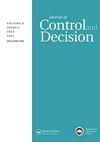Fault prediction model in wind turbines using deep learning structure with enhanced optimisation algorithm
IF 1.8
4区 工程技术
Q3 AUTOMATION & CONTROL SYSTEMS
引用次数: 0
Abstract
AbstractDigital Twin (DT) is used for lifetime monitoring of the drive train and can be a costly option. This proposal adopts the predictive modelling of wind turbines by digital twins by deep learning strategies. Initially, the data is acquired from publicly available wind turbine datasets. Next, the deep features and statistical features are extracted, and the autoencoder is adapted to get the deep features. Then, the Enhanced Marine Predators Algorithm (EMPA) is to select the optimal weighted fused features, where the EMPA would tune the weights used for fusion and the features selection. Finally, the predictive modelling is done via a newly recommended Adaptive Deep Temporal Convolution Network with an Attention Mechanism (ADTCN-AM). It is tuned for precise outcomes with the help of EMPA for forecasting the wind speed and predicting the generated power. The comparative performance analysis of the recently used wind prediction system model shows better efficient results.KEYWORDS: Twin predictive model in wind turbinesfeature extractionenhanced marine predators algorithmadaptive deep temporal convolution network with attention mechanismoptimal weighted fused features Disclosure statementNo potential conflict of interest was reported by the author(s).Practical implicationThe real-time-based twin prediction model in wind turbines gives the computer-oriented solutions for next-generation. It is utilised to generate a digital copy of wind farms interconnected with the physical wind turbines for analysis and prediction process. It helps analyse and understand wind farms easily. It helps to deal with the issue of real-time control of the characteristics of UAV swarm. It includes context-awareness capabilities, which are utilised to identify cybersecurity problems in real time for smart grid deployments.Additional informationNotes on contributorsMahendra Bhatu GawaliMahendra Bhatu Gawali received his BE degree in 2008, M.E. degree in 2013 and Ph.D. degree in 2019 from University of Mumbai, MS, India. Currently he working as Professor in IT department of Sanjivani College of Engineering, Kopargaon, Savitribai Phule Pune University, Pune, MS, India. His area of interests is Digital Twin, Cognitive Intelligence, Artificial Intelligence, Cloud Computing, Optimisation.Swapnali Sunil GawaliSwapnali Sunil Gawali is working as assistant professor in the computer engineering department of Sanjivani College of Engineering, Kopargaon. She has completed her BE and ME from Savitribai Phule Pune University, Pune. Her area of interest is data mining, artificial intelligence.Megharani PatilMegharani Patil is an associate professor in the computer engineering department of Thakur College of Engineering and Technology, Mumbai, and head of the department of artificial intelligence and machine learning. She has received her PhD from the University of Mumbai. Her area of research interest is user experience design and intelligent systems. She has published her research papers in many national and international journals and conferences. A patent is registered in her name, and she has published two books.基于深度学习结构和增强优化算法的风力发电机故障预测模型
摘要数字孪生(DT)用于传动系统的寿命监测,可能是一个昂贵的选择。该方案采用深度学习策略,采用数字孪生模型对风力涡轮机进行预测建模。最初,这些数据是从公开可用的风力涡轮机数据集中获得的。其次,提取深度特征和统计特征,并采用自编码器提取深度特征。然后,采用增强型海洋捕食者算法(Enhanced Marine predator Algorithm, EMPA)选择最优加权融合特征,调整融合所使用的权重和特征选择。最后,通过新推荐的具有注意机制的自适应深度时间卷积网络(ADTCN-AM)进行预测建模。在EMPA的帮助下,它被调整为精确的结果,用于预测风速和预测发电量。对近年来常用的风力预报系统模型进行了性能对比分析,结果表明预报效果较好。关键词:风力涡轮机孪生预测模型;特征提取增强海洋捕食者算法;带注意机制的自适应深度时间卷积网络;最优加权融合特征;实际意义基于实时的双子星预测模型为下一代风力涡轮机提供了面向计算机的解决方案。它被用来生成与物理风力涡轮机相连的风力发电场的数字副本,用于分析和预测过程。它有助于分析和理解风力发电场。它有助于解决无人机群特性的实时控制问题。它包括上下文感知功能,用于实时识别智能电网部署的网络安全问题。mahendra Bhatu Gawali于2008年获得印度孟买大学学士学位,2013年获得硕士学位,2019年获得博士学位。目前,他在印度浦那Savitribai Phule Pune University, Kopargaon的Sanjivani工程学院担任IT系教授。他的兴趣领域是数字孪生,认知智能,人工智能,云计算,优化。Swapnali Sunil Gawali是Kopargaon Sanjivani工程学院计算机工程系的助理教授。她已经完成了浦那Savitribai Phule Pune大学的学士和硕士学位。她感兴趣的领域是数据挖掘和人工智能。Megharani Patil是孟买塔库尔工程技术学院计算机工程系的副教授,也是人工智能和机器学习系主任。她在孟买大学获得博士学位。她的研究兴趣是用户体验设计和智能系统。她在许多国内和国际期刊和会议上发表了研究论文。以她的名义注册了一项专利,并出版了两本书。
本文章由计算机程序翻译,如有差异,请以英文原文为准。
求助全文
约1分钟内获得全文
求助全文
来源期刊

Journal of Control and Decision
Mathematics-Control and Optimization
CiteScore
2.80
自引率
17.60%
发文量
76
 求助内容:
求助内容: 应助结果提醒方式:
应助结果提醒方式:


